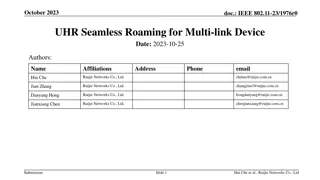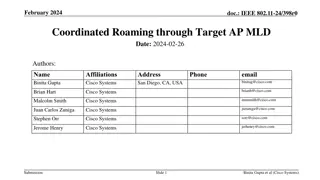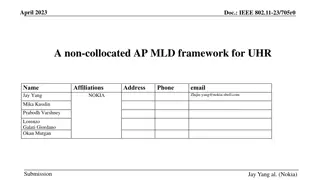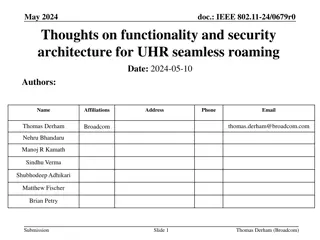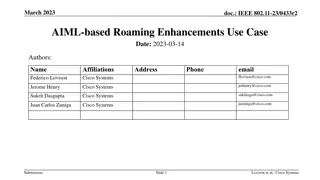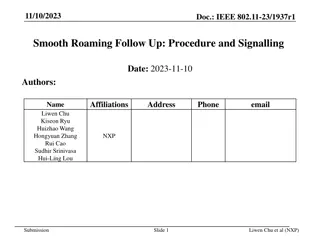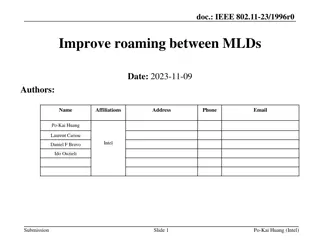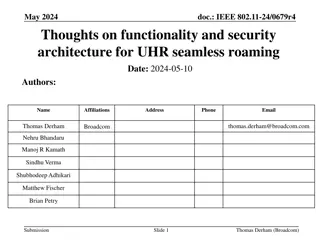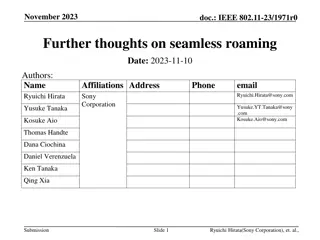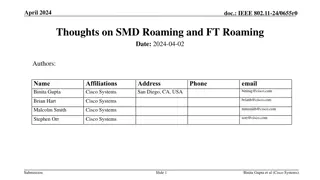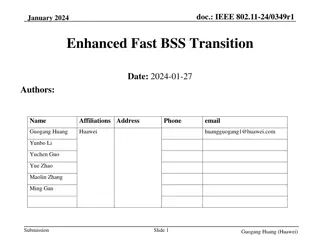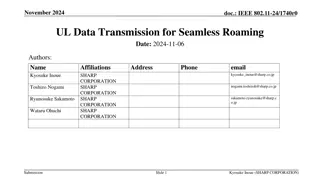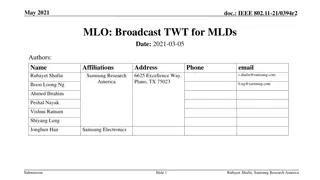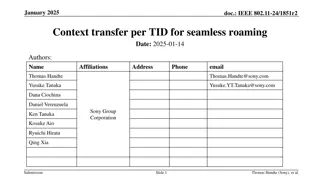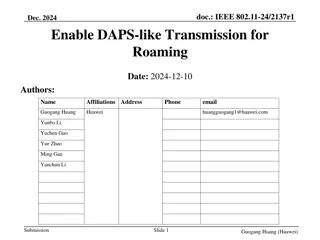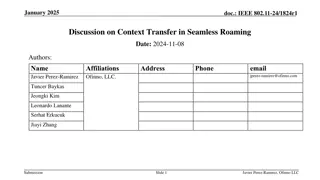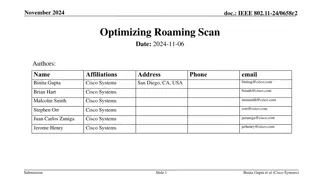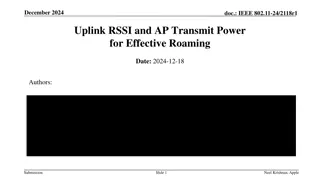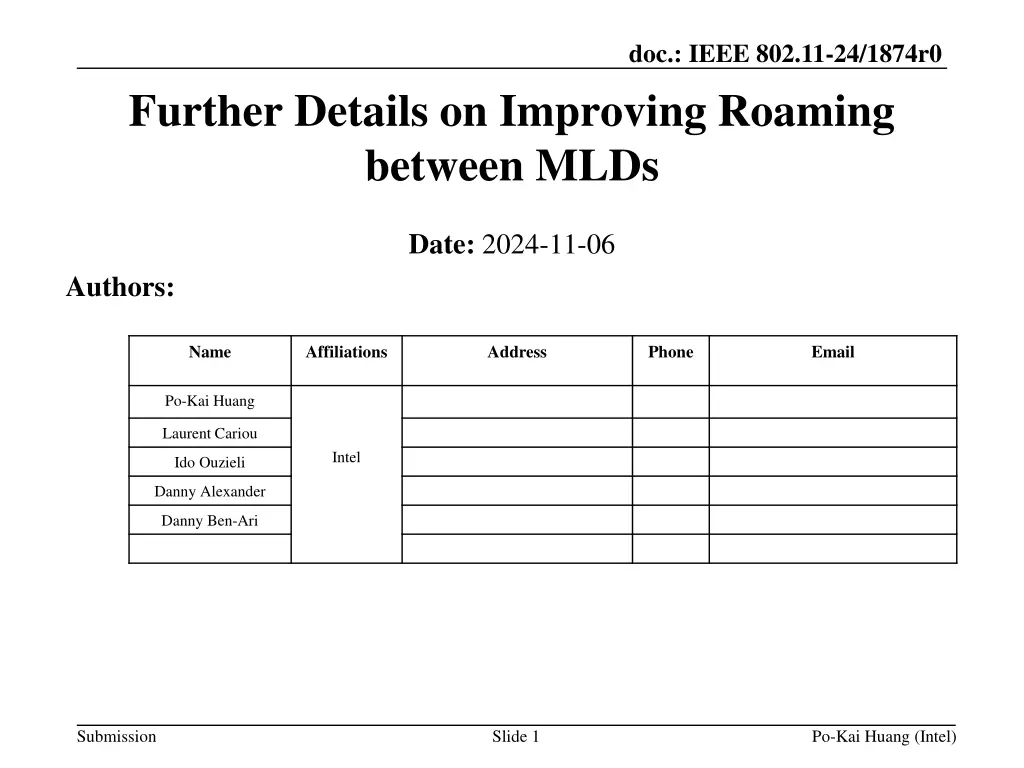
Improving Roaming Efficiency in IEEE 802.11 Networks
Explore the details of enhancing roaming between MLDs in IEEE 802.11 networks. This presentation discusses high-level roaming procedures, context transfer, data continuity, and security considerations for seamless transitions between access points.
Uploaded on | 2 Views
Download Presentation

Please find below an Image/Link to download the presentation.
The content on the website is provided AS IS for your information and personal use only. It may not be sold, licensed, or shared on other websites without obtaining consent from the author. If you encounter any issues during the download, it is possible that the publisher has removed the file from their server.
You are allowed to download the files provided on this website for personal or commercial use, subject to the condition that they are used lawfully. All files are the property of their respective owners.
The content on the website is provided AS IS for your information and personal use only. It may not be sold, licensed, or shared on other websites without obtaining consent from the author.
E N D
Presentation Transcript
doc.: IEEE 802.11-24/1874r0 Further Details on Improving Roaming between MLDs Date: 2024-11-06 Authors: Name Affiliations Address Phone Email Po-Kai Huang Laurent Cariou Intel Ido Ouzieli Danny Alexander Danny Ben-Ari Submission Slide 1 Po-Kai Huang (Intel)
doc.: IEEE 802.11-24/1874r0 Abstract High level roaming procedure is agreed to achieve data continuity Exchange of request/response to initiate DS mapping change and context transfer from current AP MLD to target AP MLD A transient period to receive DL data from current AP MLD and allow DL/UL data exchange with target AP MLD Roam with DS mapping notification End of roaming procedure Current AP MLD Target AP MLD Current AP MLD Target AP MLD Current AP MLD Target AP MLD Non-AP MLD Non-AP MLD Non-AP MLD State 4 State 4 We provide further details for the following aspects in this presentation: Contexts related to BA agreement Context related to security Submission Slide 2 Po-Kai Huang (Intel)
doc.: IEEE 802.11-24/1874r0 DL Consideration Example for DL only: Roam with DS mapping notification End of roaming procedure Current AP MLD Target AP MLD Current AP MLD Target AP MLD Current AP MLD Target AP MLD Non-AP MLD Non-AP MLD Non-AP MLD State 4 State 4 The key consideration is during the transient period, where we need the design to support data coming from both current AP MLD and target AP MLD, which can be done sequentially The simplest approach to minimize implementation complexity on non-AP MLD is for non-AP MLD to keep using the existing receiving reordering buffer This aligns with existing BA setup because receive reordering buffer size depends only on the buffer size indication of non-AP MLD for DL agreement WinStartO WinEndO WinStartO WinEndO Current AP MLD Target AP MLD WinEndB WinStartB Non-AP MLD Submission Slide 3 Po-Kai Huang (Intel)
doc.: IEEE 802.11-24/1874r0 DL Consideration WinStartO WinEndO WinStartO WinEndO Current AP MLD Target AP MLD WinEndB WinStartB Non-AP MLD Relevant context from current AP MLD to target AP MLD to enable the operations Block Ack Parameters and Block Ack Timeout Value indicated by the non-AP MLD for existing DL BA agreement Next SN to be assigned for DL individually addressed data frame of each TID, which can have a large gap to make it semi-static WinStartO of an existing DL BA agreement so that the target AP MLD does not exceed reordering buffer window of the non-AP MLD Submission Slide 4 Po-Kai Huang (Intel)
doc.: IEEE 802.11-24/1874r0 UL Consideration Example for UL only: Roam with DS mapping notification End of roaming procedure Current AP MLD Target AP MLD Current AP MLD Target AP MLD Current AP MLD Target AP MLD Non-AP MLD Non-AP MLD Non-AP MLD State 4 State 4 WinStartO WinEndO WinStartO WinEndO WinStartO WinEndO The key consideration is for non-AP MLD to continue transmission of data in the queue SN/PN that has been assigned shall be allowed to be reused rather than reassignment, which complicates the transmission queue implementation Relevant context from current AP MLD to target AP MLD to enable the operations Block Ack Parameters and Block Ack Timeout Value indicated by the non-AP MLD for existing UL BA agreement (Note that these are advisory information) latest SN that has been pass up to the next MAC process for TID with UL BA agreement, which can be used by target AP MLD to construct WinStartB Latest duplicate receiver cache for TID without BA agreement. This avoids cases when non-AP MLD retransmits data that has been passed up to target AP MLD, which happens when non-AP MLD misses the Acknowledgement Submission Slide 5 Po-Kai Huang (Intel)
doc.: IEEE 802.11-24/1874r0 Context related to security The option to preserve one PN space during roaming is useful due to following consideration For DL, simplify replay check implementation on one received reordering buffer For UL, simplify existing transmission queues implementation without the need to reassign PN Potentially, no need to be burdened with additional key derivation during roaming Note that this requirement is natural with one PTK, but can also be done with different PTK, which is currently under discussion Relevant context from current AP MLD to target AP MLD to enable the operations Starting PN to be assigned for DL individually addressed frame by the target AP MLD, which can have a large gap to make it semi-static Submission Slide 6 Po-Kai Huang (Intel)
doc.: IEEE 802.11-24/1874r0 Conclusion We discuss the essential contexts that needs to be transferred from current AP MLD to target AP MLD during roaming to enable data continuity Block Ack Parameters and Block Ack Timeout Value indicated by the non-AP MLD for existing BA agreement of a TID Starting SN to be assigned for DL individually addressed data frame of each TID by the target AP MLD Starting PN to be assigned for DL individually addressed frame by the target AP MLD WinStartO of an existing DL BA agreement so that the target AP MLD does not exceed reordering buffer window of the non-AP MLD latest SN that has been pass up for TID to the next MAC process with UL BA agreement Latest duplicate receiver cache for TID without BA agreement Submission Slide 7 Po-Kai Huang (Intel)
doc.: IEEE 802.11-24/1874r0 Straw Poll for the non-AP MLD? Do you support to enable the following contexts to be transferred to target AP MLD to preserve the data exchange context Block Ack Parameters and Block Ack Timeout Value indicated by the non-AP MLD for existing BA agreement of a TID Starting SN to be assigned for DL individually addressed data frame of each TID by the target AP MLD Starting PN to be assigned for DL individually addressed frame by the target AP MLD WinStartO of an existing DL BA agreement so that the target AP MLD does not exceed reordering buffer window of the non-AP MLD Latest duplicate receiver cache for TID without BA agreement latest SN that has been pass up for TID to the next MAC process with UL BA agreement TBD for other contexts Note TBD on the agreed buffer size with the target AP MLD Submission Slide 8 Po-Kai Huang (Intel)

